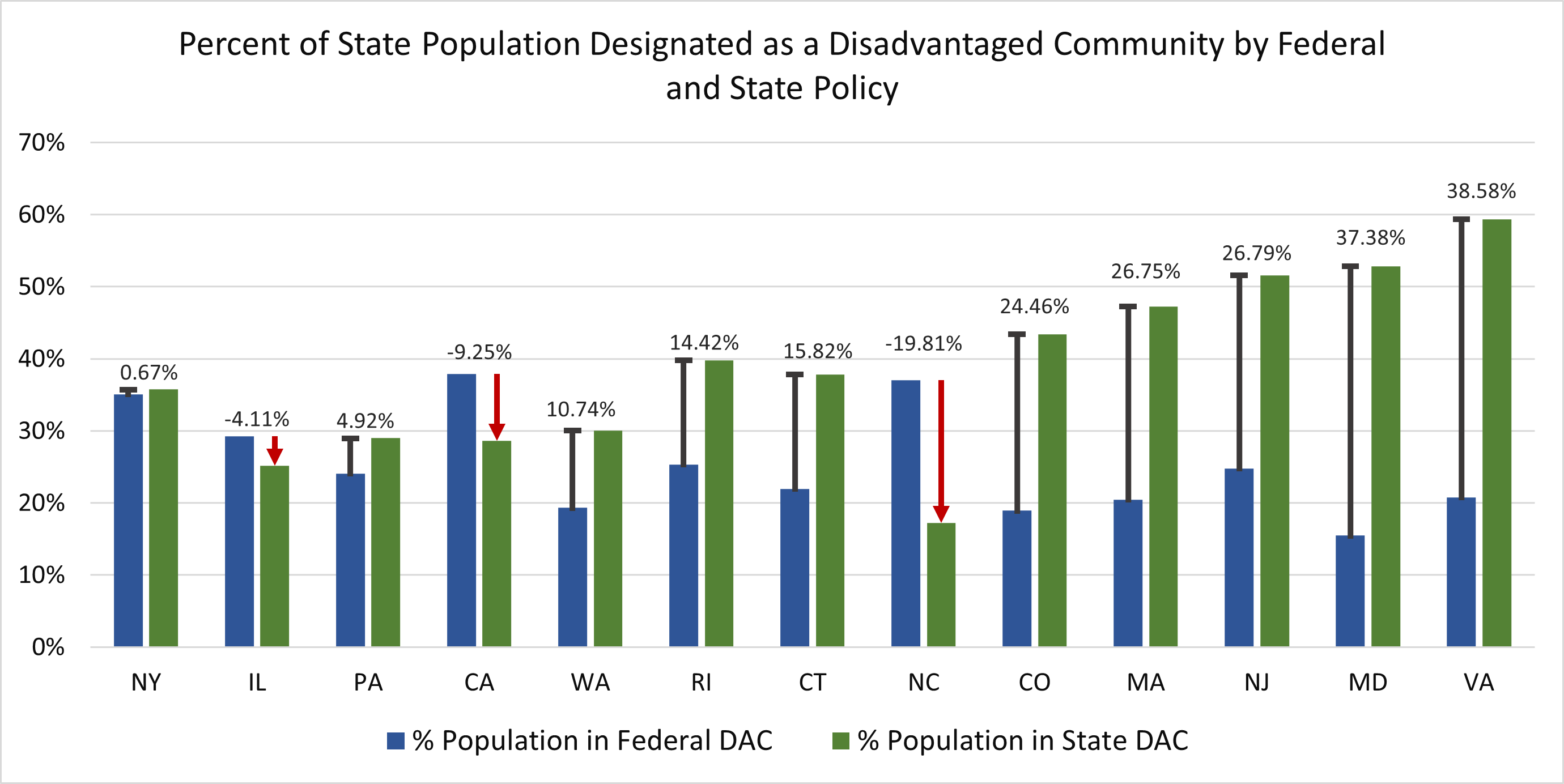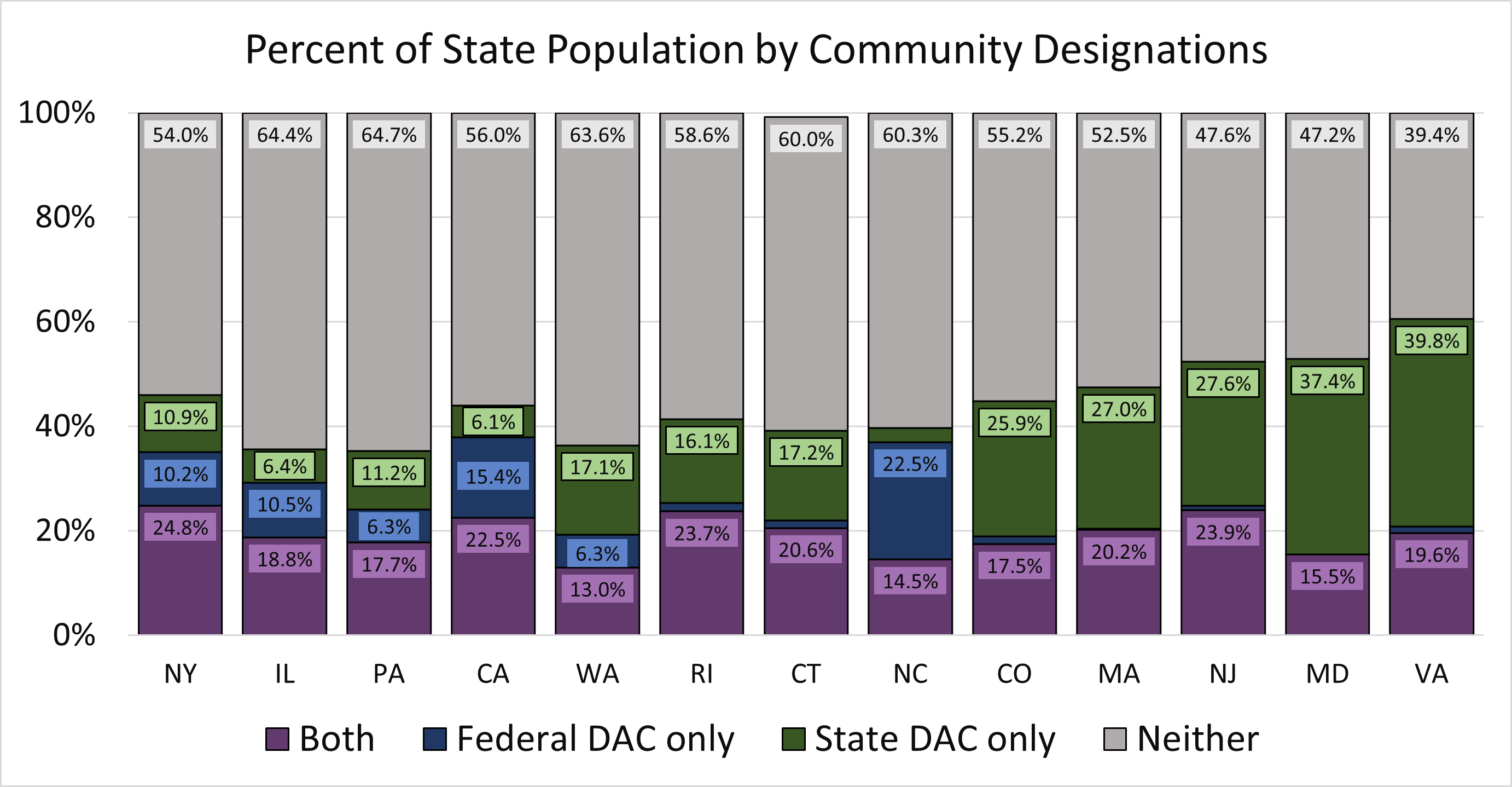May 17th, 2023
By Marisa Sotolongo
As federal funding from the Inflation Reduction Act (IRA) is disbursed to state and local governments, and as federal tax incentives spur private investments in clean energy infrastructure projects, major questions remain about whether this funding will truly benefit the nation’s disadvantaged communities and low-income households. Different government entities have developed varying definitions of disadvantaged communities that qualify for funding earmarks, compliance and enforcement interventions, impact assessments, or other policy interventions, but there is a lack of systemic tracking and reporting of where funding is being spent and how these policy interventions are benefitting disadvantaged communities. This makes it difficult to evaluate whether this funding benefits disadvantaged communities through transformative change or simply reifies the existing economic system by bolstering investor-owned utility structures and investing in “false solutions”, such as “clean coal” and natural gas infrastructure. This could further cement existing inequality in the United States by concentrating federal investment funding and benefits in the hands of private corporations, the wealthy, and White households.
After the 2020 election, federal agencies began working on plans to implement the Biden Administration’s Justice40 Initiative, which promises that “40 percent of the overall benefits of certain federal investments flow to disadvantaged communities that are marginalized, underserved, and overburdened by pollution.” The White House Council on Environmental Quality (CEQ) concurrently developed its Climate and Economic Justice Screening Tool (CEJST) and a definition of disadvantaged communities as it relates to the Justice40 Initiative. Additionally, many states have their own definitions of environmental justice, underserved, overburdened, and disadvantaged communities that are being folded into state policies for permit requirements, energy infrastructure investment, and pollution reduction. These state and federal definitions overlap and conflict in ways that can be generative or unproductive. Overlap in these definitions could be helpful, if different definitions highlight a diverse map of vulnerabilities across populations and allow policymakers to direct program funding to communities that most need investment. Alternatively, these divergent definitions could leave policymakers uncertain about how to appropriately allocate funding with these different definitions. They could also erase local and contextual factors that sustain inequity and injustice, or create barriers to accessing funding.
Planning for Analysis of Funding Distribution and Benefits Allocation
Several key questions arise from these varying approaches to defining disadvantaged communities and attempting to track the funding allocated to these communities:
- How will federal agencies publish information on which communities are receiving the benefits of all this infrastructure funding?
- Will states disburse their federal funding according to the federal definition of disadvantaged communities, their own definitions of disadvantaged communities, or neither?
- How do we define benefits? Do expenditures have to occur within a disadvantaged community to count? Or is it more important to identify which expenditures are benefitting disadvantaged communities, regardless of where the funding is spent?
It is crucial that we begin asking these questions now, instead of analyzing the potential inequitable distribution of funding after the fact. Much of this funding has not yet reached the communities it is intended to benefit. Building on IEJ’s past work analyzing Justice40 policy and community definitions, this blog post highlights data gaps, research methods, and a possible evaluation framework to trace the distribution of government investments, in accordance with varying definitions of disadvantaged communities. Using this analysis, we conclude that policymakers must increase transparency and accountability around which communities receive funding, and whether this funding truly benefits these communities.
Federal and State Designations of Disadvantaged Communities
The federal definition of disadvantaged communities was officially released with the CEJST mapping tool in November 2022. It is an interactive map of the United States with metrics for economic and climate justice concerns displayed at the census tract level. It includes whether the census tract in question qualifies as disadvantaged. There are multiple environmental and climate indicator thresholds (listed here) which qualify a census tract as a disadvantaged community. Several critiques from research and environmental justice organizations have pointed out the shortcomings and inequities built into this version of the CEJST– specifically, CEQ’s decision to exclude race and ethnicity from the federal definition of disadvantaged communities. (World Resources Institute, Center for Neighborhood Technology & EPIC) This decision works against recognition justice, a key tenet of environmental and energy justice, which requires that the cumulative and interconnected impacts of racial injustice, environmental degradation, and economic disenfranchisement imposed on poor communities and communities of color (specifically Black and Indigenous communities and people) are recognized and addressed.
Thirteen states have a legislative or state agency definition of disadvantaged communities. Four of these states—California, Illinois, New York, and Washington—allocate a percent of program funding to their state disadvantaged communities. All but two states, California and Connecticut, use race and ethnicity in their state definitions. Figure 1 shows a comparison between the percent of a state’s population that is federally designated disadvantaged versus the percent of that state’s population that is living in a state-designated disadvantaged community. The detailed population data can be found in the supplemental materials, linked in Appendix A below.

Figure 1: The percent of each state’s population that resides in a census tract designated disadvantaged by state or federal policy, relative to the total state population. The difference between the percent of a state’s population living in a federally-designated disadvantaged community and the percent of a state’s population living in a state-designated disadvantaged community is noted for each state.
Illinois, New York, California, and Pennsylvania have federally-designated and state-designated disadvantaged community populations that fall within 10% of one another. We define these states as “closely aligned” states. Washington, North Carolina, Rhode Island, Connecticut, Massachusetts, New Jersey, Colorado, Maryland, and Virginia have a difference in federally-designated and state-designated disadvantaged community populations that exceed 10%, and can be considered “divergent” states.
-
- Of the “divergent” states, Washington and Colorado use a cumulative EJ index, with environmental pollution, climate vulnerability, and demographic indicators, to define disadvantaged communities at the state level. Three of the “closely aligned” states, Illinois, New York, and California also take this approach.
- Pennsylvania, Rhode Island, Connecticut, Massachusetts, New Jersey, Maryland, and Virginia define disadvantaged communities solely using demographic information.
- Maryland and Virginia have state legislation that defines disadvantaged communities by demographic indicators only – however, these states are also in the midst of defining a separate category of communities, called “overburdened communities” and “fenceline communities,” respectively, that are defined based solely on environmental pollution indicators.
- North Carolina is an interesting outlier, with a very narrowly defined state disadvantaged community definition. This is likely the result of the policy conditions under which North Carolina developed its state definition – as a condition of an environmental justice lawsuit settlement.
In our previous analysis, we highlighted four states that allocate funding to their state-designated disadvantaged communities. California, Illinois, New York, and Washington decided how much funding will be statutorily allocated to their state-designated disadvantaged communities, then passed on responsibility for defining these communities to state agencies (with public participation and feedback requirements). This process appears to have resulted in a fairly close mirroring of population percentages in state-designated disadvantaged communities and funding percentages. Figure 1 shows that for California, Illinois, and New York, the population living in federally-designated disadvantaged communities closely aligns with the population determined by state-designated disadvantaged communities. For states that have divergent definitions, allocating federal funding only to federally-designated disadvantaged communities will leave out significant swaths of the state’s population that are recognized as disadvantaged by the state government.
Spatial Divergence of Federal and State Designations of Disadvantaged Communities
Analyzing how much of each state’s population is state or federally-designated disadvantaged is useful, but it can obscure the fact that different communities might make up these numbers. For example, California’s state-designated disadvantaged communities have significant overlap with federally-designated disadvantaged communities. However, there are significant areas in rural counties that are only designated as disadvantaged by federal standards (see Figure 2).

Figure 2: Census tracts in California that are designated as state disadvantaged communities (left) and federal disadvantaged communities (right). Data provided by the California Environmental Protection Agency and the White House Council on Environmental Quality.
This difference varies based on the state in question. Figure 3 shows an alternative way of analyzing state populations based on disadvantaged community designation–census tracts that are considered disadvantaged by both the federal and state governments, either one or the other, or neither. A comprehensive analysis of populations among state-designated and federally-designated disadvantaged communities is beyond the scope of this blog post, but key areas for further research include the race and ethnicity of these populations; specific energy access or affordability barriers; vulnerability to flooding, wildfire, drought, and extreme heat or cold; and health outcomes.

Figure 3: The percent of each state’s population that resides in a census tract designated disadvantaged by state and federal policy, solely by one or the other, or not designated disadvantaged by either, relative to the total state population. Population percentages that are less than 5.0% are not shown in this figure. Details for these calculations can be found in the Appendix.
Many states have significant populations that are only recognized as disadvantaged by the federal government and not by the state government. In Washington, Illinois, New York, California, and North Carolina, more than 5% of the population live in communities designated disadvantaged by the federal government, and not the state government. Other states have expansive state-designated disadvantaged community definitions that almost entirely encompass the federally-designated disadvantaged communities. Pennsylvania, Rhode Island, Connecticut, Massachusetts, New Jersey, Colorado, Maryland, and Virginia have expansive state-designated disadvantaged community definitions. In these states, federally-designated disadvantaged communities are also eligible for state programs for disadvantaged communities, but the reverse is not true. These communities might have more access to matching funds to leverage larger amounts of grant funding.
The overlap and divergence of state and federal definitions of disadvantaged communities is important not for the sake of these definitions on their own.These definitions provide a useful way to analyze how government program funding is distributed and how policy interventions are implemented across different communities. We turn to an example of this analysis in the next section.
State Approaches to Tracking Benefits to Disadvantaged Communities
California’s system for tracking benefits to state disadvantaged communities is the most comprehensive in the country; therefore, it is the natural place to start analyzing the differences between federal and state-designated disadvantaged communities. California allocates revenue from its state cap-and-trade program to disadvantaged communities and low-income households, and provides an interactive mapping tool, dashboard, annual report, list of covered programs, and a map of disadvantaged communities, with data download options for all of these mapping tools. For each project, the spatial location, funding amounts, disadvantaged or low-income beneficiaries are noted, and non-monetary benefits are described and cataloged in detail. This level of detail should be, at minimum, matched for federal programs subject to the Justice40 Initiative.
One program covered by California’s cap-and-trade revenues is a state Low-Income Weatherization Assistance Program, which provides incentives for energy efficiency, weatherization, and solar voltaic systems in low-income single- and multi-family homes. Figure 2 shows the state and federally-designated disadvantaged communities in California. Table 1 summarizes the program’s projects between 2015 and 2022 and the funding breakdown for state and federal disadvantaged communities.
| Total number of projects | 6,381 |
| Total number of project incentives | 29,728 |
| Total project funding from state fund | $181,827,481 |
| Funding for projects in state DACs | $144,485,320 (79.5%) |
| Funding for projects in federal DACs | $136,726,487 (75.2%) |
Table 1: California’s state Low-Income Weatherization Assistance Program data for projects between 2015-2022. Data is provided by the California state government: https://webmaps.arb.ca.gov/ccimap/.
Table 2 shows the project, incentive, and funding breakdowns for communities based on their disadvantaged designation. The biggest chunk of projects, incentives, and funding goes to communities that are state and federally designated, followed by communities that are state-designated only. Both these groups receive funding disproportionate to their population percentages (22.5% and 6.1%, respectively, of the state population). Communities designated as disadvantaged by the federal government, but not the state, and communities not designated disadvantaged by either, receive fewer of the projects, incentives, and funding shares, especially given their share of the state’s population. The level of detail in California’s data reporting allows for this type of evaluation and analysis, which can help researchers identify populations that are receiving – or not receiving – benefits from various funding programs.
| Federal and State | State, not Federal | Federal, not State | Neither | |
| Number of projects |
4,812 (74.4%) |
824 (12.9%) |
447 (7.0%) |
298 (4.7%) |
| Number of project incentives |
23,653 (79.6%) |
3,082 (10.4%) |
1,802 (6.1%) |
1,190 (4.0%) |
| Funding for projects | $125,001,586 (76.4%) | $19,483,734 (11.9%) | $11,724,901 (7.2%) | $7,519,991 (4.6%) |
| Population |
8,847,939 (22.5%) |
2,401,990 (6.1%) |
6,034,642 (15.4%) |
21,998,926 (56.0%) |
Table 2: California’s state Low-Income Weatherization Assistance Program data for projects between 2015-2022, based on federal and state disadvantaged community definitions. The total state population residing in these disadvantaged communities is provided as well. Data on project incentive funding is provided by the California state government https://webmaps.arb.ca.gov/ccimap/.
As more states adopt legislation and policies that define disadvantaged communities, and federal funding continues to roll out for CEJST-defined disadvantaged communities in states with and without state-designated disadvantaged community definitions, this question of benefits allocation and tracking funding will only become more complicated, especially without investment in data infrastructure to evaluate metrics for recognition and distributive justice.
Conclusions and Recommendations
- As states continue defining, regulating, and allocating benefits to disadvantaged communities, detailed reporting and data transparency is necessary to promote third-party program evaluation and analysis. California has the most functional tracking system, and both it and Illinois should be used as models for other states or federal attempts to create similar tracking systems.
- Benefits can be defined in different ways: a “dollars first” approach, where funding amounts are earmarked, or a “co-benefits” approach, which include metrics related to health, workforce development, pollution reduction, etc. in benefits calculations. There are tradeoffs between the approaches that should be considered based on the local political context and priorities of frontline organizations. A dollars-first approach is easier to quantify and track, and could prevent false political promises of investments in communities that never materialize meaningfully. However, co-benefits align with a more holistic conceptualization of environmental justice, though might be more difficult to implement, as it would require more tracking and data specificity. This particular issue will be explored further in a future blog post!
- Many states that define disadvantaged communities do not have an option for communities to self-designate – this flexibility to self-designate as a disadvantaged community will be key as state and federal definitions of disadvantaged communities are used to allocate funding for all sorts of projects.
- Not all “benefits” align with advancing environmental justice. There are countless infrastructure investment projects, such as biomass facilities, solar panel waste disposal facilities, hydrogen plants, investments in privately owned utilities, and more. These might promise benefits to the local community, but fail to meaningfully advance justice.
Appendix A: Methodology and Population Calculations

